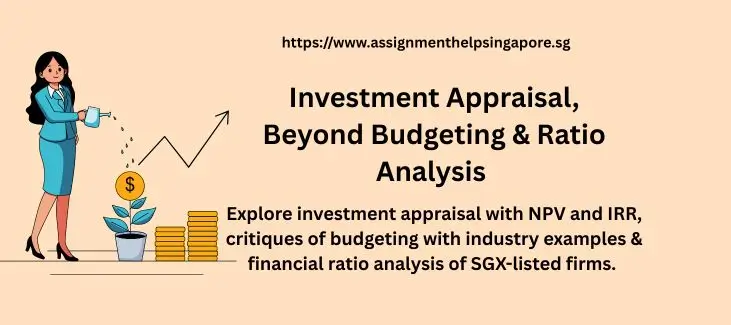
Contents
Investment Appraisal, Beyond Budgeting & Ratio Analysis – Financial Management Assignment
Question 1
Investment Appraisal
(20 Marks)
Your company is evaluating two investment opportunities, Project Imur and Project Unij. However, due to financial constraints, only one project can be undertaken.
Below is the projected data for each project:
| Project | Imur($’000) | Unij($’000) |
| Initial Cost | (120,000) | (150,000) |
| Net Profit | ||
| Year 1 | 18,000 | 36,000 |
| Year 2 | 30,000 | 48,000 |
| Year 3 | 42,000 | (80,000) |
| Year 4 | 52,500 | 20,000 |
| Year 5 | 37,500 | 10,000 |
| Year 6 | – | 5,000 |
Additional Information:
- All cash flows occur at the end of the respective year, except for the initial investment, which is made at the beginning of the project.
- Project Imur: The machinery will be disposed of at the end of Year 5, with an expected scrap value of $10 million.
- Project Unij: The machinery will be disposed of at the end of Year 3 with no scrap value. Replacement machinery will be purchased at this point for $9 million.
- The cost of this replacement machinery has already been included in the Year 3 profit projection for Project Unij.
- The replacement machinery is expected to last for three years with no residual value.
- The company depreciates all assets on a straight-line basis.
- The company applies a discount rate of 15% for investment appraisals.
Required:
a) Calculate the annual cash flows for each of the projects.
(5 Marks)
b) Use the investment appraisal methods to calculate the NPV and IRR for both projects.
(10 Marks)
c) Based on your calculations, advise the company on which project should be accepted or rejected. Provide a clear explanation of the financial and strategic implications of your recommendation.
(5 Marks)
Question 2
Beyond budgeting – Reform or abandon budgeting? (40 Marks)
Budgeting has faced significant criticism over the years. Jan Wallander famously described it as “an unnecessary evil,” while Jack Welch called it the “bane of corporate America.” Critics argue that traditional budgeting is increasingly ineffective in today’s dynamic business environment, where competition and the growing importance of intellectual capital challenge conventional financial planning methods. As a result, some advocate for abandoning budgets altogether, while others propose reforming them to better align with modern business realities.
Task:
Select one industry from the list below and critically evaluate one budgeting technique and one budgeting process commonly used within that industry. Discuss the validity of the criticisms against budgeting in the context of current global challenges, such as economic volatility, digital transformation, sustainability and changing market dynamics.
List of Industries:
- Manufacturing
- Banking
- Shipbuilding
- Retail
- Oil & Gas
- Logistics & Supply Chain
- Pharmaceutical & Biotechnology
Your critique should address the following:
- Should traditional budgeting be abandoned? If so, what viable alternatives exist?
- If budgeting should be reformed, what improvements or new approaches would be most effective?
- Support your discussion with insights from major behavioural (motivation) theorists, as well as practical industry examples to strengthen your argument.
Question 3
Ratio Analysis
(40 Marks)
You are required to analyse the financial performance of a listed company over a period of three (3) financial years. The company must have a listing on the Singapore Exchange (SGX) mainboard. You are required to undertake independent research to review current annual company reports, market reports and academic literature to support your findings in your report.
(a) Financial Ratio Analysis
(30 Marks)
- Select and calculate at least 10 financial ratios to assess the company’s profitability, liquidity and solvency over the three-year period.
- Use charts and tables to illustrate trends and comparisons.
- Analyse the audited financial statements and conduct further research to provide clear explanations for each ratio, linking them to the company’s overall performance.
(b) Limitations of Ratio Analysis
(10 Marks)
- Discuss the limitations of only using ratio analysis as a tool to interpret company performance.
You are expected to research for more information on the company and cite the material correctly.
Accounting Assignment Answers: Experts Answer on Above Investment Appraisal Questions
The calculation of annual gas flows for each of the projects such as Project Imur and Project Unij is performed as follows:
Project Imur: This project has a 5 year life and the calculation of cash flow requires adding depreciation to the net profit. The total depreciation is 120m and the project has a value of 10m which needs to be deducted. So it will be 120m-10m which will be 110m, as the project has a useful life of 5 years, so each year depreciation will be 110m/5 = 22m
Cash flow = Net profit+depreciation as calculated below:
| Project | Imur($’000) | |||
| Initial Cost | -120,000 | Depreciation | Scrap | Cash Flow |
| Net Profit | | |||
| Year 1 | 18,000 | 22000 | 40,000 | |
| Year 2 | 30,000 | 22000 | 52,000 | |
| Year 3 | 42,000 | 22000 | 64,000 | |
| Year 4 | 52,500 | 22000 | 74,500 | |
| Year 5 | 37,500 | 22000 | 10000 | 69,500 |
Project Unij: Machine 1 has 3 years life and machine 2 has 3 years life, so depreciation for first three years is 150000/3= 50000 and next 3 years is 9000/3=3000
| Project | Unij($’000) | Depreciation | Scrap | Cash Flow |
| Initial Cost | -150,000 | |||
| Net Profit | ||||
| Year 1 | 36,000 | 50000 | 86,000 | |
| Year 2 | 48,000 | 50000 | 98,000 | |
| Year 3 | -80,000 | 50000 | -30,000 | |
| Year 4 | 20,000 | 3000 | 23,000 | |
| Year 5 | 10,000 | 3000 | 13,000 | |
| Year 6 | 5,000 | 3000 | 8,000 |
| Disclaimer: This answer is a model for study and reference purposes only. Please do not submit it as your own work. |
Want a Full Worked Out Answer with References?
Check Samples of Assignment on Accounting Subject Written by Experts
Related answers
Wealth Management & Investment Strategy Case Study
UK vs Singapore: Tackling Tax Evasion and the Tax Gap
Active vs Passive Portfolio Management Report | STI Index
Pomelle Ltd: Accounting Strategies to Cut Costs
Jag & Elk Pipes Case Study – Financial Statements and Analysis
NeuFash Ltd Case Study – Capital Investment & Valuation Analysis
NeuFash Ltd Sustainable Fashion Finance Case Study



